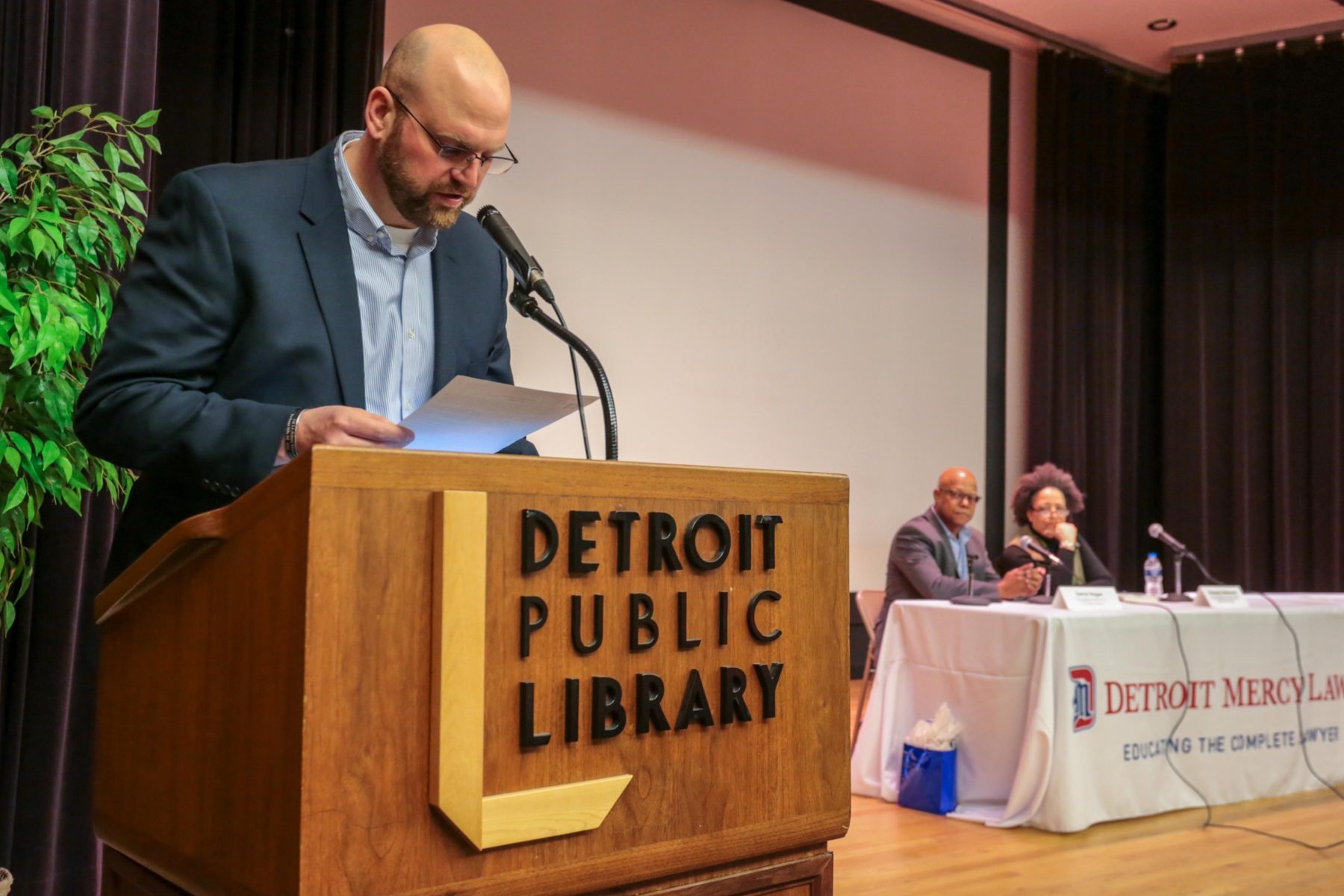
In November 2020, shortly after President Joe Biden was elected, Great Lakes Now talked with University of Detroit Mercy associate professor Nick Schroeck about the opportunities and challenges facing the president-elect.
Schroeck is an environmental law attorney and urban policy expert who has a background in transboundary legal issues between the U.S. and Canada.
Schroeck put a spotlight on Biden’s climate change and environmental justice plans – issues that Biden featured prominently in his presidential campaign. He explained the opportunities and barriers Biden faced and noted that expectations for him to deliver were high. He also noted that the backdrop of COVID-19 would be a challenge for the incoming president.
Great Lakes Now’s Gary Wilson recently checked in with Schroeck for an update on the Biden agenda after a year. Their discussion covered Biden’s policies, climate in Michigan, drinking water, and the latest on Line 5, considering that Canada has elevated the Michigan and Enbridge dispute to the highest levels of federal government in both countries.
The interview was conducted on the phone and via email and was recorded, transcribed and edited for length and clarity.
Great Lakes Now: We spoke shortly after President Biden was elected in November 2020, and you said that after dealing with COVID, climate change should be Biden’s top priority. What are his climate accomplishments so far?
Nick Schroeck: First, we need to acknowledge that we’re not done with COVID. It’s an enormous issue that the Biden administration continues to grapple with.
On climate change, the early executive orders from President Biden were very encouraging on climate and environmental justice and for communities that have been overburdened with pollution. The big setback has been his Build Back Better plan that stalled in the Senate. That plan would have included a lot of funding for clean energy, renewable energy and helping to modernize the electrical grid. It would have helped us move towards a greener future and to reduce greenhouse gas emissions.
That legislative failure is a stumbling block for the administration on their climate efforts.
There are some things Biden can do administratively, so we’re seeing action from the EPA ensuring that polluters are held accountable, for example, stricter enforcement following a decline in the previous four years.
But what we need is significant spending on transitioning to a clean energy future and legislation aimed at curbing greenhouse gas emissions. It’s important to note that the U.S. was back in a leadership role at the recent Glasgow COP26 Climate Conference.
The conference was disappointing to climate advocates who were hoping for more intensive cuts to global greenhouse gas emissions. The Glasgow conference outcome was tepid movement in the right direction when we need aggressive change.
GLN: At the state level, Michigan recently released a draft of its climate plan for comment. Does the plan effectively move past the aspirational stage to areas that can reasonably be implemented?
NS: It’s a good plan that seeks to move Michigan towards renewable energy, 50% renewable by 2035. That’s a positive step. Another goal is for the state to be carbon neutral by 2050. The criticism of the plan, which is similar to a lot of these plans, is a lack of concrete steps in terms of spending and where the investments will come from to get us to those targets.
I think 50% renewable by 2035 is achievable. Michigan is trending that way through existing investments from the utility companies and from individuals demanding clean energy options like rooftop solar.
But with a Republican controlled legislature that has been resistant to working with the governor on issues like clean energy, it remains to be seen whether the state can get legislation and budget priorities passed to make the climate plan a reality.
Until the money is designated and ready to go, it’s difficult to determine how successful the plan will be.
GLN: In that November 2020 conversation we talked about environmental justice as Biden has made it a priority like no previous president. How do you grade his efforts so far?
NS: His Justice 40 initiative executive order requires that 40% of federal money for energy development or modernization of the electric grid should go to environmental justice communities. That was a big signal the Biden administration was not just saying the right things about EJ, but requiring where federal dollars are spent the funds flow to EJ communities.
The key now is implementation. Monitoring is required to make sure that the 40% flows to these communities. With federal spending there can be gaming the system, so the Biden administration needs to be transparent and held accountable.
There have been tensions over key staff resignations on the EJ staff in the White House, so that’s concerning.
It’s also important to note that the courts have been a challenge for the Biden administration. There are discouraging signals coming from the U.S. Supreme Court about how this conservative majority will view agency or administrative action on climate change.
There are upcoming cases on the court’s docket where limiting the EPA’s authority to regulate greenhouse gas emissions is on the table. That legal cloud combined with a Congress unwilling to enact climate change and EJ legislation has a chilling effect on activity aimed at addressing EJ impacts and greenhouse gas emissions.
GLN: How effective can the federal government be on EJ issues at the local level where state laws are the root of the problem? For example, in Michigan the Department of Environment, Great Lakes and Energy recently approved a controversial air permit for an asphalt plant. The agency acknowledged that the plant is in a “neighborhood of color in economic distress” but it said the permit complied with regulations.
NS: At the federal level, the Clean Air Act definitely needs an update that would give the EPA more authority to regulate and intervene. But in Michigan, EGLE’s statement about its limitations in the asphalt case is a half-answer. Michigan is free to regulate environmental pollution in a way that is more protective of the environment. In other words, there can be more strict regulations than the federal minimum standards.
The state saying its hands are tied isn’t 100% true. The state could choose to regulate pollution from these facilities to a greater extent than what’s allowed under federal law. And there’s hesitancy on the part of state officials to be more aggressive and take on some of these facilities without the backstop of the federal government requiring it. It’s a lack of willingness to take polluting industries to task.
GLN: A textbook EJ issue is the drinking water crisis concerning high levels of lead in Benton Harbor that has prompted citizen lawsuits against the state. Last year the state settled the lawsuit brought by Flint residents, though a citizen suit against the EPA is still pending. How does Michigan get itself out of this repeating cycle of drinking water dysfunction and litigation?
NS: The key point in these lawsuits is that they’re based on regulatory failures.
It was a failure of EGLE, and its predecessor MDEQ in the case of Flint, to strictly follow the Safe Drinking Water Act. When they are getting test results that show unacceptably high levels of lead, the agency needs to have a vigorous response. They need to inform the public and work with the municipal water supply systems as soon as possible to correct the problem.
For different reasons, in Flint and Benton Harbor the regulatory system failed and it led to harm in the local communities. EGLE’s primary mission is to protect the health of Michigan’s citizens and to protect the environment – and it must respond quickly and vigorously when confronting known problems. EGLE needs to make sure that people have a safe supply of drinking water. It was frustrating to see the slow response by EGLE in providing bottled water in Benton Harbor.
At the federal level via the infrastructure bill that is now law, there are significant funds for lead service line replacement. The way we get to the safest place possible is by replacing those lead service lines as quickly as we can.
The best way for the state to avoid future litigation is to have an aggressive EGLE making sure that municipalities are following the law and that people have a safe water supply.
GLN: Regarding Line 5, in 2019 Gov. Gretchen Whitmer told Great Lakes Now that “protracted litigation” would be part of a “worst-case scenario.” But that’s exactly where the issue stands. Is there a compromise to be had, or are Michigan and Enbridge so entrenched in their positions that it will have to play out in the courts?
NS: The governor was trying to avoid some of that litigation with her revocation of the easement. It was surprising to see her make that aggressive move.
It was perhaps an attempt to avoid litigation but on the same day Michigan filed in a state court seeking judicial confirmation of their ability to cancel the easement. That action triggered lawsuits in federal court and all the legal back and forth we’ve seen in the interim.
Enbridge has made clear that the legal battle will continue and we’re still months away from getting to the merits of the arguments.
In the meantime, this old pipeline remains on the bottomlands of the Straits of Mackinac, and it poses a risk every day.
GLN: In October, Canada’s Liberal government invoked a 1977 treaty with the U.S. that prevents disruption of oil movement between the countries. Michigan Attorney General Dana Nessel has questioned the legal basis for Canada’s intervention. You have a background in transboundary law. Is Canada on firm legal ground?
NS: In invoking the treaty, Canada is within its rights to seek discussion and negotiations with the U.S based on the treaty.
From a legal perspective, what was dubious was the government of Canada seeking to insert itself into the litigation between Michigan, Enbridge and the federal court. And trying to invoke the 1977 treaty as a way to frame some of the arguments over the other legal issues like Michigan’s rights as a sovereign state.
Michigan is on its firmest ground when talking about the easement and the state’s rights to protect its environment and regulate its property and activity within its jurisdiction.
When you get to the international aspects of the dispute and regulation of interstate pipelines that cross national borders, that’s where it’s stickier for Michigan.
One aspect of the 1977 treaty that hasn’t received much attention is Article IV, which deals with pipeline safety and environmental protection. The Biden administration has some room to negotiate there. The 1977 treaty has relevance to Line 5, but there are many separate legal issues that need to be fully briefed, argued and decided.
Catch more news at Great Lakes Now:
Legal Translation: Environmental attorney explains the latest on Enbridge Line 5 news
Featured image: Nick Schroeck speaking at the Detroit Public Library (Photo Credit: Meghan Petibrin, courtesy of Nick Schroeck)




